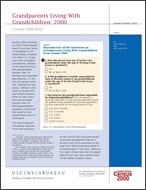Census 2000 Brief: Grandparents Living With Grandchildren: 2000
Census 2000 Brief: Grandparents Living With Grandchildren: 2000
Census 2000 enumerated 158.9 million people aged 30 and over living in households in the United States, of whom 5.8 million (or 3.6 percent) were coresident grandparents, defined in this report as living with grandchildren younger than 18.1 Among these coresident grandparents, 2.4 million (42 percent) were also “grandparent caregivers,” defined in this report as people who had primary responsibility for their coresident grandchildren younger than 18. Among grandparent caregivers, 39 percent had cared for their grandchildren for 5 or more years.
This report presents information obtained from three questions on the Census 2000 long form about coresident grandparents (Figure 1). As with most of the questions on the long form, these three were asked of all people aged 15 and over. However, this report shows data only for people aged 30 and over, since people under 30 are highly unlikely to have grandchildren.2 The first question asked if the person was the grandparent of any grandchildren under 18 who were living in the same house. Those who answered “yes” were then asked if they were “currently responsible for most of the basic needs of one or more of these grandchildren.” Grandparents who answered “yes” were further asked how long they had had this responsibility.
Census 2000 was the first time that questions on grandparental caregiving have been included in the decennial census. The Personal Responsibility and Work Opportunity Reconciliation Act of 1996 (PRWORA) directed that this topic be included on Census 2000. The Congress wanted to find out about grandparents who were the primary caregivers for their grandchildren, and if this relationship was temporary or permanent. These three questions were selected to provide information on the extent to which grandparents act as caregivers to their coresident grandchildren.
This report is part of a series that presents population and housing data collected in Census 2000. The report presents data on the population aged 30 and over living in households with grandchildren. It describes population characteristics for regions, states, counties, and the ten largest cities in the United States. The report details the geographic distribution of coresident grandparents, of grandparent caregivers, and of the length of time that they have cared for their grandchildren. Differences in these grandparent-grandchild indicators are shown by race and Hispanic origin. The proportion living in poverty and the proportion of grandparent caregivers who were in households where the grandchild’s parents were absent are also shown.
Differences in proportions of coresident grandparents and grandparent caregivers may be influenced by a variety of factors, including cultural differences in family structure (such as frequency of extended family households), differences in age distribution, migration patterns, racial and ethnic composition, housing shortages, high living costs, poverty levels, and local government policies on kinship care.
__________
1 The text of this report discusses data for the United States, including the 50 states and the District of Columbia. In addition, data for the Commonwealth of Puerto Rico are shown in Table 2 and Figure 3.
The estimates in this report are based on responses from a sample of the population. As with all surveys, estimates may vary from the actual values because of sampling variation or other factors. All comparisons made in this report have undergone statistical testing and are significant at the 90-percent confidence level.
2 This question was among a set of questions asked of all people aged 15 and over, but the tabulation universe for these data is people aged 30 and over who are living in households. The data in this report are only presented for people aged 30 and over, as very few people under 30 are grandparents. Data are shown only for people in households, as some of the characteristics used in this report (for example, relationship) are only available for household members, not for those living in group quarters such as nursing homes.
Related Information
Publication
Publication
Table
Table
Others in Series
Publication
Publication
Publication






